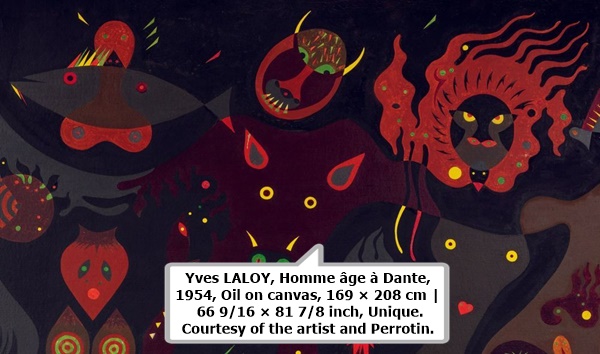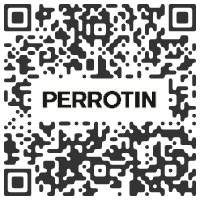"VISION"
Yves Laloy

PERROTIN
76 RUE DE TURENNE 75003 PARISTEL : +33 1 42 16 79 79 e-mail:



January 8 > March 12, 2022

Perrotin is dedicating its first monographic exhibition on Yves Laloy
(born in Rennes in 1920; died in Cancale in 1999). Some fifty works
will be on view in both gallery spaces on avenue Matignon and rue
de Turenne. Yves Laloy’s work has not been featured in a major exhibition since 2004, in a retrospective at the Musée des Beaux-Arts in
Rennes. Two of his emblematic works from that museum’s collections will be exceptionally presented here.
Yves Laloy began his career as an architect, before turning definitively to painting in 1950. From the start, he began exhibiting in Parisian galleries devoted to Surrealism, which resonated with the wordplay and irony nestled in his work. In 1958, André Breton orchestrated an exhibition for him at the Galerie La Cour d’Ingres, and wrote a laudatory preface to the catalog. A few years later, Breton selected his painting Les Petits pois sont verts, les petits poissons rouges... (1959) as the cover image for his book Le Surréalisme et la peinture. Laloy himself was never part of the Surrealist movement; he developed his work around a multifaceted ‘plastic’ vocabulary, ranging from rigorous geometric compositions to undulating, cosmogonic worlds. His works have been exhibited in Paris, Milan, Basel, and within larger exhibitions devoted to Surrealism, including the 1991 homage to André Breton at the Centre Pompidou. His independent nature and the rarity of his work have bestowed him with a fairly discreet artistic status, known mainly amongst lovers of Surrealism. The polyphony of this hard-to-classify œuvre and its unconventional curiosity invite us to look at these paintings today in a different light. They are replete with the mysteries of the cosmos and the unconscious. While Laloy’s spiritual dimension is forcefully expressed in the work, another singularity is clear, even to those looking at it today: he was a “sampler” of extremely heterogenous influences, in a way that is ultimately quite unconventional in postwar art. […]
In the early 1950s, various avant-gardes coexisted in Paris, some long established, others more recent: lyrical abstraction, the abstract landscaping of the New School of Paris, art brut, the miserabilism of Bernard Buffet; while in the United States, abstract expressionism was causing a revolution. Certain of Laloy’s paintings seem to be “more” of one or another of these, but never in a confrontational way, and indeed while we can often see similarities in his works of the 1950s and 1960s to Kandinsky, Paul Klee, Auguste Herbin (who unveiled his “Plastic Alphabet” in 1946), and above anything else, to the works of the painter and tapestry designer Jean Lurçat, popular in Paris since the 1930s, the particularities of these paintings is to summon all these sources at once, “mixing”—as we say today—the contributions of one with those of another, combining sequences from one with the DNA of another. In his paintings, Laloy makes several languages coexist, each belonging to the figurative or abstract universe, in compositions always, notoriously, asymmetrical. And more importantly, he adds to theses universes a full pantheon of influences from both the so-called minor arts and cultures from beyond Western art’s conventional perimeter—thirty years before William Rubin showed, with the exhibition “Primitivism” in 20th Century Art at MoMA in New York in 1984, what can, in a certain light, unite contemporary and tribal art. Thus, in Laloy’s paintings we see not only sampling from Kandinsky, Herbin, and Lurçat, but patterns inspired by Panamanian Indian fabrics, Incan potter, and Native American sand paintings, an early celebration of the “Magiciens de la Terre.1 ”
Eric Troncy, extract of Vision, exhibition catalog Yves Laloy,
Perrotin, 2022
Yves Laloy began his career as an architect, before turning definitively to painting in 1950. From the start, he began exhibiting in Parisian galleries devoted to Surrealism, which resonated with the wordplay and irony nestled in his work. In 1958, André Breton orchestrated an exhibition for him at the Galerie La Cour d’Ingres, and wrote a laudatory preface to the catalog. A few years later, Breton selected his painting Les Petits pois sont verts, les petits poissons rouges... (1959) as the cover image for his book Le Surréalisme et la peinture. Laloy himself was never part of the Surrealist movement; he developed his work around a multifaceted ‘plastic’ vocabulary, ranging from rigorous geometric compositions to undulating, cosmogonic worlds. His works have been exhibited in Paris, Milan, Basel, and within larger exhibitions devoted to Surrealism, including the 1991 homage to André Breton at the Centre Pompidou. His independent nature and the rarity of his work have bestowed him with a fairly discreet artistic status, known mainly amongst lovers of Surrealism. The polyphony of this hard-to-classify œuvre and its unconventional curiosity invite us to look at these paintings today in a different light. They are replete with the mysteries of the cosmos and the unconscious. While Laloy’s spiritual dimension is forcefully expressed in the work, another singularity is clear, even to those looking at it today: he was a “sampler” of extremely heterogenous influences, in a way that is ultimately quite unconventional in postwar art. […]
In the early 1950s, various avant-gardes coexisted in Paris, some long established, others more recent: lyrical abstraction, the abstract landscaping of the New School of Paris, art brut, the miserabilism of Bernard Buffet; while in the United States, abstract expressionism was causing a revolution. Certain of Laloy’s paintings seem to be “more” of one or another of these, but never in a confrontational way, and indeed while we can often see similarities in his works of the 1950s and 1960s to Kandinsky, Paul Klee, Auguste Herbin (who unveiled his “Plastic Alphabet” in 1946), and above anything else, to the works of the painter and tapestry designer Jean Lurçat, popular in Paris since the 1930s, the particularities of these paintings is to summon all these sources at once, “mixing”—as we say today—the contributions of one with those of another, combining sequences from one with the DNA of another. In his paintings, Laloy makes several languages coexist, each belonging to the figurative or abstract universe, in compositions always, notoriously, asymmetrical. And more importantly, he adds to theses universes a full pantheon of influences from both the so-called minor arts and cultures from beyond Western art’s conventional perimeter—thirty years before William Rubin showed, with the exhibition “Primitivism” in 20th Century Art at MoMA in New York in 1984, what can, in a certain light, unite contemporary and tribal art. Thus, in Laloy’s paintings we see not only sampling from Kandinsky, Herbin, and Lurçat, but patterns inspired by Panamanian Indian fabrics, Incan potter, and Native American sand paintings, an early celebration of the “Magiciens de la Terre.1 ”
Eric Troncy, extract of Vision, exhibition catalog Yves Laloy,
Perrotin, 2022
 | Yves Laloy | |
mpefm
FRANCE art press release
Opening Saturday January 8
Open Hours :
Tuesday - Saturday 10am - 6pm

Opening Saturday January 8
Open Hours :
Tuesday - Saturday 10am - 6pm
QR of this press release
in your phone, tablet








